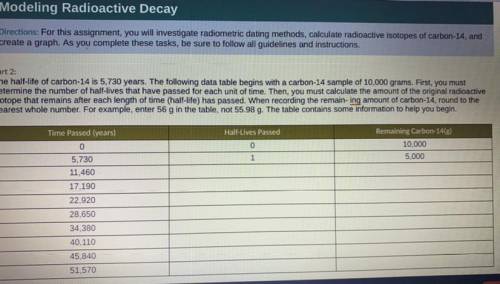Please Help!
Modeling Radioactive Decay
Directions: For this assignment, you will investigate...

Please Help!
Modeling Radioactive Decay
Directions: For this assignment, you will investigate radiometric dating methods, calculate radioactive isotopes of carbon-14, and
create a graph. As you complete these tasks, be sure to follow all guidelines and instructions.
Part 2:
The half-life of carbon-14 is 5,730 years. The following data table begins with a carbon-14 sample of 10,000 grams. First, you must
determine the number of half-lives that have passed for each unit of time. Then, you must calculate the amount of the original radioactive
isotope that remains after each length of time (half-life) has passed. When recording the remaining amount of carbon-14, round to the
nearest whole number. For example, enter 56 g in the table, not 55.98 g. The table contains some information to help you begin.


Answers: 2


Another question on Physics

Physics, 22.06.2019 03:30
Starting with only the balmer series light (visible light), how could we ensure that the solar panels generate a current that mark can use for his power station? a)by gradually increasing the brightness (amount) of light that we shine on it. b)by gradually increasing the frequency of the light we shine on it. c)by gradually increasing the wavelength of the light that we shine on it.
Answers: 3


Physics, 22.06.2019 12:50
Arunner is jogging at a steady 3.6 km/hr. when the runner is 2.9 km from the finish line, a bird begins flying from the runner to the finish line at 14.4 km/hr (4 times as fast as the runner). when the bird reaches the finish line, it turns around and flies back to the runner. even though the bird is a dodo, we will assume that it occupies only one point in space, i.e., a zero-length bird. how far does the bird travel? (b) after this first encounter, the bird then turns around and flies from the runner back to the finish line, turns around again and flies back to the runner. the bird repeats the back and forth trips until the runner reaches the finish line. how far does the bird travel from the beginning? (i.e. include the distance traveled to the first encounter)
Answers: 2

Physics, 22.06.2019 15:30
What are the north and south poles of a solenoid change with?
Answers: 1
You know the right answer?
Questions

Mathematics, 15.05.2021 03:20






Chemistry, 15.05.2021 03:20


Mathematics, 15.05.2021 03:20

Health, 15.05.2021 03:20

Mathematics, 15.05.2021 03:20


Mathematics, 15.05.2021 03:20

Mathematics, 15.05.2021 03:20

Physics, 15.05.2021 03:20







